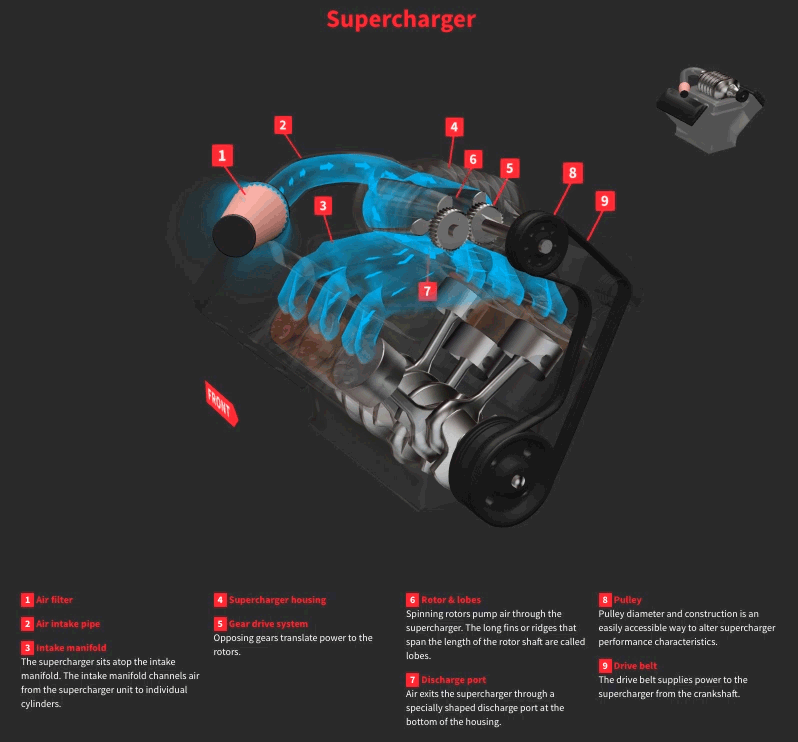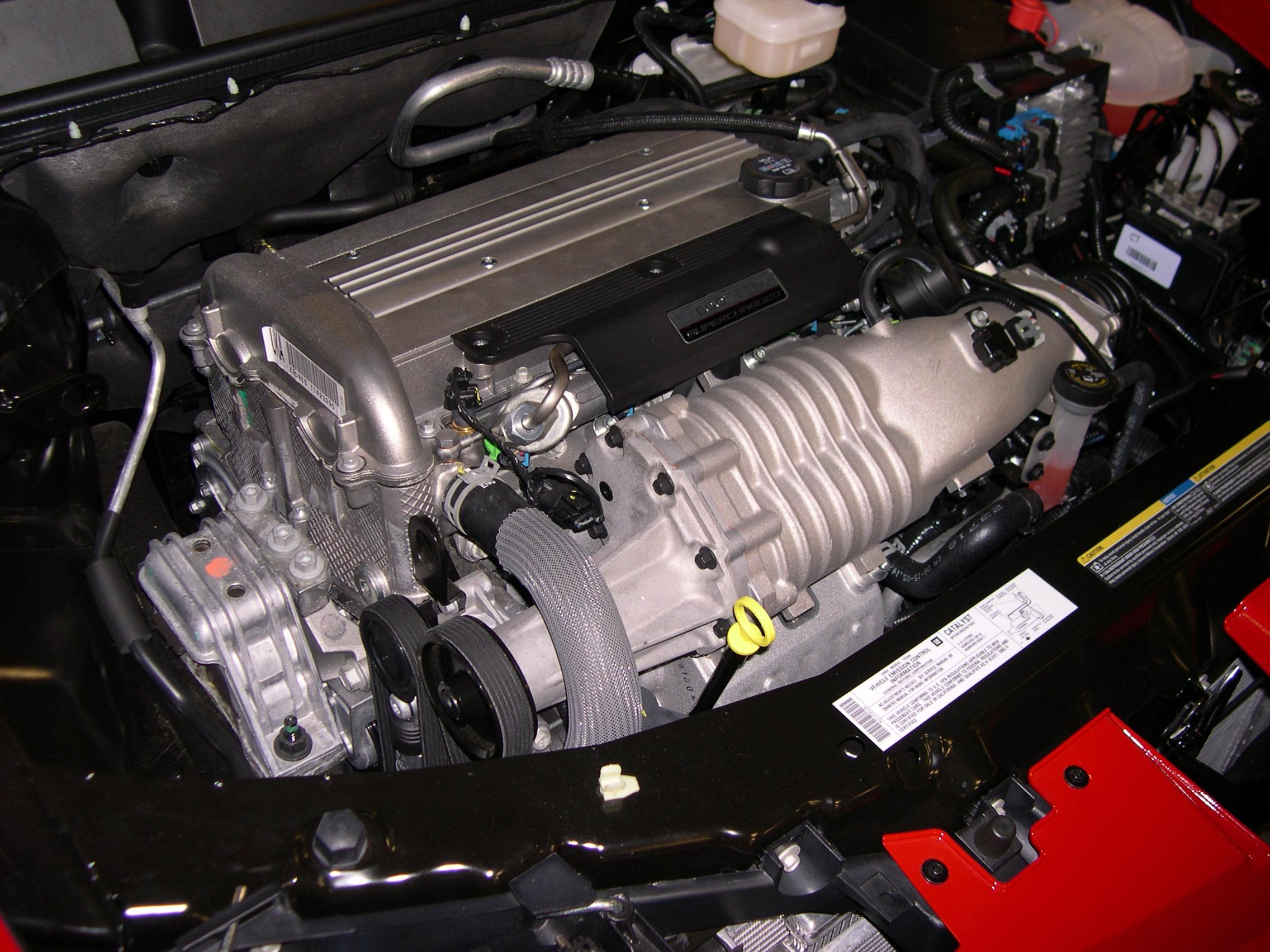|
Exhaust Pulse Pressure Charging
Exhaust pulse pressure charging (EPPC) is a system for supercharging two-stroke diesel engines of the loop-scavenge type. Loop-scavenge engines cannot be pressure-charged in the same way as uniflow engines or four-stroke engines because the inlet and exhaust ports are open at the same time. Overview The engine usually has a Roots blower to provide air for scavenging and this is arranged to deliver excess air so that air follows the exhaust gases into the exhaust manifold. Some of this air is then forced back into the cylinder by a rise in pressure in the exhaust manifold resulting from the exhaust pulse from another cylinder. For additional pressure charging a turbocharger may be fitted, in series with the Roots blower, but a turbocharger cannot be used alone as it would not provide enough air for scavenging at low speeds. Examples Exhaust pulse pressure charging was used by Crossley in these diesel locomotive engines: * the HST-Vee 8, used in the British Rail Class 28, the C ... [...More Info...] [...Related Items...] OR: [Wikipedia] [Google] [Baidu] |
Supercharger
In an internal combustion engine, a supercharger compresses the intake gas, forcing more air into the engine in order to produce more power for a given displacement (engine), displacement. It is a form of forced induction that is mechanically powered (usually by a belt from the engine's crankshaft), as opposed to a turbocharger, which is powered by the kinetic energy of the exhaust gases. However, up until the mid-20th century, a turbocharger was called a "turbosupercharger" and was considered a type of supercharger. The first supercharged engine was built in 1878, with usage in aircraft engines beginning in the 1910s and usage in car engines beginning in the 1920s. In piston engines used by aircraft, supercharging was often used to compensate for the lower air density at high altitudes. Supercharging is less commonly used in the 21st century, as manufacturers have shifted to turbochargers to reduce fuel consumption and increase power outputs, especially with reduced engine dis ... [...More Info...] [...Related Items...] OR: [Wikipedia] [Google] [Baidu] |
WAGR X Class
The WAGR X class is a now-withdrawn class of diesel locomotives built by Beyer, Peacock & Company and Metropolitan-Vickers, Bowesfield Works, Stockton-on-Tees for the Western Australian Government Railways (WAGR) between 1954 and 1956. Several members of the class have been preserved. Construction In the early 1950s the Western Australian Government Railways placed the largest single Australian order for diesel locomotives, when it ordered 48 2-Do-2 locomotives from Beyer, Peacock and Company and Metropolitan-Vickers. All were delivered between 1954 and 1956. The seeds for the construction of the class were laid in by the then WAGR Chief Mechanical Engineer, Tom Marsland, with a proposal for the acquisition of 87 diesel locomotives, including 3 small jetty shunters, 18 diesel shunters and 66 mainline locomotives, later reduced to 48 when railcars were selected for suburban service. The proposal developed further during discussions with Beyer, Peacock regarding issues with th ... [...More Info...] [...Related Items...] OR: [Wikipedia] [Google] [Baidu] |
Superchargers
In an internal combustion engine, a supercharger compresses the intake gas, forcing more air into the engine in order to produce more power for a given displacement. It is a form of forced induction that is mechanically powered (usually by a belt from the engine's crankshaft), as opposed to a turbocharger, which is powered by the kinetic energy of the exhaust gases. However, up until the mid-20th century, a turbocharger was called a "turbosupercharger" and was considered a type of supercharger. The first supercharged engine was built in 1878, with usage in aircraft engines beginning in the 1910s and usage in car engines beginning in the 1920s. In piston engines used by aircraft, supercharging was often used to compensate for the lower air density at high altitudes. Supercharging is less commonly used in the 21st century, as manufacturers have shifted to turbochargers to reduce fuel consumption and increase power outputs, especially with reduced engine displacements. Design ... [...More Info...] [...Related Items...] OR: [Wikipedia] [Google] [Baidu] |
Pressure Wave Supercharger
A pressure wave supercharger (also known as a wave rotor) is a type of supercharger technology that harnesses the pressure waves produced by an internal combustion engine exhaust gas pulses to compress the intake air. Its automotive use is not widespread; the most widely used example is the ''Comprex'', developed by Brown Boveri.A Review of Wave Rotor Technology and its Applications including details of Comprex supercharger In automobiles Valmet Tractors of Finland were one of the first to use the device when they fitted it to the 411CX engine which powered their 1203 model of 1980. Although it provided a useful increase in performance it was considered too expensive to be incorporated into later mo ...[...More Info...] [...Related Items...] OR: [Wikipedia] [Google] [Baidu] |
Kadenacy Effect
The Kadenacy effect is an effect of pressure-waves in gases. It is named after Michel Kadenacy who obtained a French patent for an engine utilizing the effect in 1933. There are also European and US patents. In simple terms, the momentum of the exhaust gas leaving the cylinder of an internal combustion engine creates a pressure-drop in the cylinder which assists the flow of a fresh charge of air, or fuel-air mixture, into the cylinder. The effect can be maximized by careful design of the inlet and exhaust passages. Uses The Kadenacy effect has been utilized in pulse jet engines and in two-stroke piston engines and is important in the design of high-performance motorcycle engines. Pulse jets Two-stroke engines In a two-stroke engine the pressure-drop resulting from the Kadenacy effect assists the flow of a fresh fuel-air mixture charge into the cylinder. However, the Kadenacy effect alone is not sufficient and must be boosted in some way. In small engines this is done by crankcas ... [...More Info...] [...Related Items...] OR: [Wikipedia] [Google] [Baidu] |
Inertial Supercharging Effect
The inertial supercharging effect is the increase of volumetric efficiency in the cylinder of an engine. Background The internal combustion engine is a very common engine found in mechanical devices across the world. The engine is powered by an air/gasoline mixture and the physics principles of heat and pressure. Overview Inertial supercharging effect is the result of incoming fuel/air charge developing momentum greater than intake stroke would generate alone. It is achieved by the careful design of the shape of the piston head, the valves and cam profile/ valve timing which creates a vacuum that pulls more exhaust gases (and some of the intake gasses) out of the engine. This is immediately followed by a reflected pressure wave timed to force the extra intake gasses back into the cylinder, thus achieving a greater mass of air/fuel mix in the combustion chamber than possible with conventional methods. Expansion chambers only work well at a narrow engine speed range which is wh ... [...More Info...] [...Related Items...] OR: [Wikipedia] [Google] [Baidu] |
Backpressure
Back pressure (or backpressure) is the term for a resistance to the desired flow of fluid through pipes. Obstructions or tight bends create backpressure via friction loss and pressure drop. In distributed systems in particular event-driven architecture, back pressure is a technique to regulate flow of data, ensuring that components do not become overwhelmed. Explanation A common example of backpressure is that caused by the exhaust system (consisting of the exhaust manifold, catalytic converter, muffler and connecting pipes) of an automotive four-stroke engine, which has a negative effect on engine efficiency, resulting in a decrease of power output that must be compensated by increasing fuel consumption. In a piston-ported two-stroke engine, however, the situation is more complicated, due to the need to prevent unburned fuel/air mixture from passing right through the cylinders into the exhaust. During the exhaust phase of the cycle, backpressure is even more undesir ... [...More Info...] [...Related Items...] OR: [Wikipedia] [Google] [Baidu] |
British Rail Class D3/3
British Rail Class D3/3 was a 0-6-0 shunting locomotive built by British Rail at their Derby Works in England. It was similar to the British Rail Class 08, except they were built with different engines and traction motors. They were all withdrawn and scrapped after only twelve years of service. See also * List of British Rail classes A list is a set of discrete items of information collected and set forth in some format for utility, entertainment, or other purposes. A list may be memorialized in any number of ways, including existing only in the mind of the list-maker, but ... References * * D003.03 C locomotives Railway locomotives introduced in 1955 Scrapped locomotives Standard-gauge locomotives of Great Britain Diesel–electric locomotives of Great Britain Shunting locomotives {{diesel-loco-stub ... [...More Info...] [...Related Items...] OR: [Wikipedia] [Google] [Baidu] |
CIE 201 Class
CIE may refer to: Organizations * Cambridge International Examinations, an international examination board * Center for International Education at the University of Massachusetts-Amherst * Cleveland Institute of Electronics, a private technical and engineering educational institution * International Commission on Illumination (''Commission internationale de l'éclairage'') * Companion of the Order of the Indian Empire (C.I.E.) * Computability in Europe, an international organization of computability theorists, computer scientists, mathematicians * CIÉ (Córas Iompair Éireann), the Irish state transport authority * Council on Islamic Education * Transportes Aéreos Cielos Andinos, ICAO code: CIE * Civil Information and Education Section (CIE), General Headquarters, the Supreme Commander for the Allied Powers in Japan (1945–1952) Science and technology * CIE 1931 color space, one of the first mathematically defined color spaces, created by the International Commission on ... [...More Info...] [...Related Items...] OR: [Wikipedia] [Google] [Baidu] |
Two-stroke Cycle
A two-stroke (or two-stroke cycle) engine is a type of internal combustion engine that completes a power cycle with two strokes of the piston, one up and one down, in one revolution of the crankshaft in contrast to a four-stroke engine which requires four strokes of the piston in two crankshaft revolutions to complete a power cycle. During the stroke from bottom dead center to top dead center, the end of the exhaust/intake (or scavenging) is completed along with the compression of the mixture. The second stroke encompasses the combustion of the mixture, the expansion of the burnt mixture and, near bottom dead center, the beginning of the scavenging flows. Two-stroke engines often have a higher power-to-weight ratio than a four-stroke engine, since their power stroke occurs twice as often. Two-stroke engines can also have fewer moving parts, and thus be cheaper to manufacture and weigh less. In countries and regions with stringent emissions regulation, two-stroke engines have b ... [...More Info...] [...Related Items...] OR: [Wikipedia] [Google] [Baidu] |
British Rail Class 28
The British Rail Class 28 ( Metro-Vick Type 2) diesel-electric locomotives, known variously as 'Metrovicks', 'Crossleys' or 'Co-Bos', were built under the Pilot Scheme for diesel locomotives as part of the British Railways 1955 Modernisation Plan. These Crossley-engined locomotives were one of two designs built under the Pilot Scheme to use two-stroke diesel engines, the other being the Class 23 'Baby Deltic' locomotives. The locomotives had a Co-Bo wheel arrangement (a 6-wheel bogie at one end, a 4-wheel bogie at the other) – unique in British Railways practice and uncommon in other countries, although Japan also used some C-B diesel hydraulics. The maximum tractive effort of was unusually high for a Type 2 locomotive but, as there were five (not four) driving axles, the risk of wheelslip was minimal. Origin Work had begun on the Pilot Scheme in 1954 and the first plan for 174 locomotives (all classes) had been produced by October 1954, including 20 of these Metr ... [...More Info...] [...Related Items...] OR: [Wikipedia] [Google] [Baidu] |






